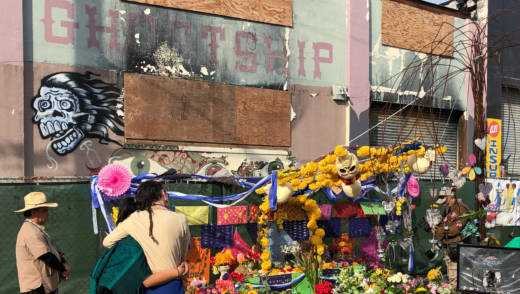Harris, one of two defendants each charged with 36 counts of involuntary manslaughter, described his role at the Fruitvale district warehouse to Bureau of Alcohol, Tobacco, Firearms and Explosives investigators on Dec. 7, just days after the fire. Jurors in the trial heard a recording of the interview Tuesday in court.
Prosecutors called to the stand one of the ATF agents, Whitney Hameth, as well as Alameda County District Attorney’s Office investigator Cinda Stoddard, who described the contents of Harris’ cellphone, in an effort to show the defendant’s outsized role in managing the warehouse that’s been called a “death trap.”
The evidence and testimony, delivered on what was expected to be prosecutors’ second to last day of calling witnesses, seemed to counter the defense’s depiction of Harris as a benignly helpful figure at an artist collective run without hierarchy or bosses.
The defense has also said the fire resulted not from the actions or neglect of Harris and codefendant Derick Almena, who held the lease, but from arson.
Prosecutors allege Harris and Almena built and operated the warehouse with a willful disregard for safety, making them criminally responsible for the deaths, while the defense has attempted to shift blame to the property owner and government officials who visited Ghost Ship without flagging unsafe conditions.
“I helped facilitate the vision of the space,” Harris told the ATF agent. “If there was interpersonal conflict, sometimes I’d have to be the mediator.” Laughing, Harris was forthcoming and self-deprecating about his duties. “I’m like the executive director, but I have my hand this far down the toilet.”
Asked if his responsibilities included maintenance, Harris responded, “Yes.” The power, delivered from an adjacent unit via extension cords, was a persistent problem. He said fuses would “literally explode.”
At another point in the recording, Harris said that although he sometimes communicated with the property owner, “I never thought to reach out to the landlord to insist they install [fire sprinklers].”
Also in the ATF interview, Harris described blocking off certain areas of the warehouse in anticipation of the electronic music event on the night of the fire, and generally fielding requests to book the space.
Under cross-examination, Harris’ attorney Curtis Briggs asked Hameth if the defendant voluntarily agreed to the interview and provided useful information. Hameth responded that Harris was cooperative.
Stoddard, the District Attorney’s Office investigator, whose testimony will continue Wednesday, described writing search warrants for the contents of Harris’ cellphone and email account. Almena’s phone wasn’t recovered, she said.
Prosecutors projected photographs extracted from the phone, including one of what appeared to be a handwritten rental agreement between Harris and a tenant indicating the collection of a “$500 security deposit for studio space at Satya Yuga,” another name for the Ghost Ship warehouse.
Harris also described himself as the space’s manager, and referred to Ghost Ship as “my warehouse,” in direct messages to other users of the dating app Tinder, which prosecutors also projected for jurors.
“I’m just getting ready for an event I’m about to host,” he wrote in a Tinder direct-message the day before the fire. In a different exchange on Tinder, he wrote, “I manage a hidden gem here in Oakland[.]”

